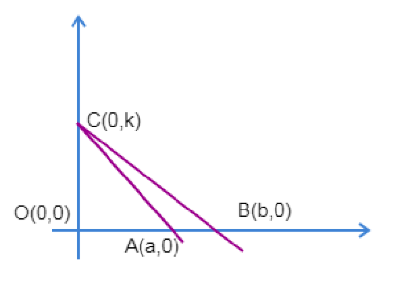
Let A(a,0) and B(b,0) be fixed distance points on the x-axis, none of which coincides with the origin O(0,0), and let C be a point on the y-axis. Let L be a line through the O(0,0) and perpendicular to the line AC. The locus of the point of intersection of the lines L and BC if C varies along the y-axis, is (provided \[{{c}^{2}}+ab\ne 0\]).
(a) \[\dfrac{{{x}^{2}}}{a}+\dfrac{{{y}^{2}}}{b}=x\]
(b) \[\dfrac{{{x}^{2}}}{a}+\dfrac{{{y}^{2}}}{b}=y\]
(c) \[\dfrac{{{x}^{2}}}{b}+\dfrac{{{y}^{2}}}{a}=x\]
(d) \[\dfrac{{{x}^{2}}}{b}+\dfrac{{{y}^{2}}}{a}=y\]
Answer
608.7k+ views
Hint: Assume a variable point C on y axis as (0,k) and find the slope of the line AC. Using the perpendicularity condition of lines, find the slope of the line C and thus the equation of line L. Finally, substitute the expression of \[k\] that you have obtained from L on the line BC for the required locus.
Given \[A\left( a,0 \right)\]and \[B\left( b,0 \right)\] are two fixed points on x axis, let us assume the variable point C on y axis as \[\left( 0,k \right)\].
Plotting the diagram with the above data, we will have it as:

Then the slope of the line AC is given as:
\[m=\dfrac{{{y}_{2}}-{{y}_{1}}}{{{x}_{2}}-{{x}_{1}}}\]
\[m=\dfrac{k-0}{0-a}\]
\[m=\dfrac{-k}{a}\]
Now the slope of the line perpendicular to line AC is \[\dfrac{-1}{m}\], since the product of slopes of perpendicular lines is -1.
Therefore, the equation of line L passing through origin and perpendicular to AC is given as:
\[y=\left( \dfrac{-1}{m} \right)x\]
\[y=\left( \dfrac{a}{k} \right)x\]
\[k=\dfrac{ax}{y}\]
Now the equation of line BC can be found out using \[\dfrac{x}{a}+\dfrac{y}{b}=1\](intercept form) where a and b are x-intercepts and y-intercept respectively.
Therefore, the equation of line BC is:
\[\dfrac{x}{a}+\dfrac{y}{k}=1\]
Substituting \[k=\dfrac{ax}{y}\] in the above equation we will have:
\[\dfrac{x}{b}+\dfrac{y}{\left( \dfrac{ax}{y} \right)}=1\]
\[\dfrac{x}{b}+\dfrac{{{y}^{2}}}{ax}=1\]
\[\begin{align}
& \\
& \dfrac{{{x}^{2}}}{b}+\dfrac{{{y}^{2}}}{a}=x \\
\end{align}\]
Thus, the locus of point of intersection of L and BC is given as \[\dfrac{{{x}^{2}}}{b}+\dfrac{{{y}^{2}}}{a}=x\]
Hence, option A is the correct answer.
Note: For any given two lines having slopes \[{{m}_{1}}\] and \[{{m}_{2}}\], then the condition for them to be parallel is \[{{m}_{1}}={{m}_{2}}\] and the condition to be perpendicular is \[{{m}_{1}}.{{m}_{2}}=-1\]. Also, \[\frac{x}{a}+\frac{y}{b}=1\], is the intercept form of a line where a and b are x-intercept and y-intercept respectively.
Given \[A\left( a,0 \right)\]and \[B\left( b,0 \right)\] are two fixed points on x axis, let us assume the variable point C on y axis as \[\left( 0,k \right)\].
Plotting the diagram with the above data, we will have it as:

Then the slope of the line AC is given as:
\[m=\dfrac{{{y}_{2}}-{{y}_{1}}}{{{x}_{2}}-{{x}_{1}}}\]
\[m=\dfrac{k-0}{0-a}\]
\[m=\dfrac{-k}{a}\]
Now the slope of the line perpendicular to line AC is \[\dfrac{-1}{m}\], since the product of slopes of perpendicular lines is -1.
Therefore, the equation of line L passing through origin and perpendicular to AC is given as:
\[y=\left( \dfrac{-1}{m} \right)x\]
\[y=\left( \dfrac{a}{k} \right)x\]
\[k=\dfrac{ax}{y}\]
Now the equation of line BC can be found out using \[\dfrac{x}{a}+\dfrac{y}{b}=1\](intercept form) where a and b are x-intercepts and y-intercept respectively.
Therefore, the equation of line BC is:
\[\dfrac{x}{a}+\dfrac{y}{k}=1\]
Substituting \[k=\dfrac{ax}{y}\] in the above equation we will have:
\[\dfrac{x}{b}+\dfrac{y}{\left( \dfrac{ax}{y} \right)}=1\]
\[\dfrac{x}{b}+\dfrac{{{y}^{2}}}{ax}=1\]
\[\begin{align}
& \\
& \dfrac{{{x}^{2}}}{b}+\dfrac{{{y}^{2}}}{a}=x \\
\end{align}\]
Thus, the locus of point of intersection of L and BC is given as \[\dfrac{{{x}^{2}}}{b}+\dfrac{{{y}^{2}}}{a}=x\]
Hence, option A is the correct answer.
Note: For any given two lines having slopes \[{{m}_{1}}\] and \[{{m}_{2}}\], then the condition for them to be parallel is \[{{m}_{1}}={{m}_{2}}\] and the condition to be perpendicular is \[{{m}_{1}}.{{m}_{2}}=-1\]. Also, \[\frac{x}{a}+\frac{y}{b}=1\], is the intercept form of a line where a and b are x-intercept and y-intercept respectively.
Recently Updated Pages
Why are manures considered better than fertilizers class 11 biology CBSE

Find the coordinates of the midpoint of the line segment class 11 maths CBSE

Distinguish between static friction limiting friction class 11 physics CBSE

The Chairman of the constituent Assembly was A Jawaharlal class 11 social science CBSE

The first National Commission on Labour NCL submitted class 11 social science CBSE

Number of all subshell of n + l 7 is A 4 B 5 C 6 D class 11 chemistry CBSE

Trending doubts
What is meant by exothermic and endothermic reactions class 11 chemistry CBSE

What are Quantum numbers Explain the quantum number class 11 chemistry CBSE

What is periodicity class 11 chemistry CBSE

Explain zero factorial class 11 maths CBSE

What is a periderm How does periderm formation take class 11 biology CBSE

Mention the basic forces in nature class 11 physics CBSE




